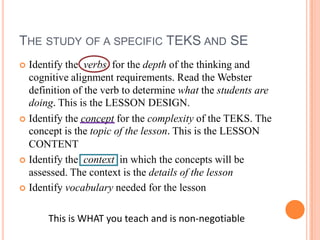Understanding the teks
- 2. Closing the GapsGaps in your data are gaps in your curriculum, not gaps in your teachers or studentsThe TEKS tell us what to teach.If we are not completely identifying and teaching all parts of the TEKS, then there will be gaps in our data.
- 3. The study of a specific TEKS and SEIdentify the verbs for the depth of the thinking and cognitive alignment requirements. Read the Webster definition of the verb to determine what the studentsare doing. This is the LESSON DESIGN.Identify the concept for the complexity of the TEKS. The conceptis the topic of the lesson. This is the LESSON CONTENTIdentify the context in which the concepts will be assessed. The contextis the details of the lessonIdentify vocabularyneeded for the lessonThis is WHAT you teach and is non-negotiable
- 4. Identify the verbs for the depthUsing an example from Math:7.9 Measurement. The student solves application problems involving estimation and measurement. The student is expected to:(B) connect models for volume of prisms (triangular and rectangular) and cylinders to formulas of prisms (triangular and rectangular) and cylinders.(C) estimate measurements and solve application problems involving volume of prisms (rectangular and triangular) and cylinders.
- 5. Webster definitionsConnect – make a logical connection; to join, link or fasten togetherEstimate – to calculate approximatelySolve – to work out the answer or solution toThis is the LESSON DESIGNThe verbs tell you what the students are doing in the lesson
- 6. Identify the concept for the complexity7.9 Measurement. The student solves application problems involving estimation and measurement. The student is expected to:(B) connect models for volume of prisms (triangular and rectangular) and cylinders to formulas of prisms (triangular and rectangular) and cylinders.(C) estimate measurements and solve application problems involving volume of prisms (rectangular and triangular) and cylinders.
- 7. For the lesson, there should be:models (concrete and pictorial) of 3D solids, formulas (or equations or expressions) for volumemeasurements (Are students measuring or are they given measurements? If given measurements, how will they estimate? These are questions that can be clarified by looking at the test history later.)application problems (word problems, real world and mathematical)This is the LESSON CONTENTCheck this list with your IFD
- 8. Identify the context 7.9 Measurement. The student solves application problems involving estimation and measurement. The student is expected to:(B) connect models for volume of prisms (triangular and rectangular) and cylinders to formulas of prisms (triangular and rectangular) and cylinders.(C) estimate measurements and solve application problems involving volume of prisms (rectangular and triangular) and cylinders.
- 9. In what ways will the concepts be tested?The only models, formulas and volumes that should be included in the lesson are rectangular & triangular prisms and cylindersWhat vocabulary should be used?Formula
- 10. Equation
- 11. Expression
- 12. Estimate
- 13. Approximate
- 14. Closest toAgain, check your IFD for more information
- 15. A look at the test history could have some clarifications7.9(B) only one released question. Given a word problem (this is stated in the stem of the TEKS) and picture with measurements, plug the numbers into the formula correctly. Answer choices are numbers in a formula, not a solution7.9(C) many released questions. Students measure using a formula chart and they are given measurements. Allare word problems, some with pictures some without. The “estimate measurement” questions are all about cylinders where they estimate π. All answers are numerical solutions.
- 16. NOW look through your resources for aligned lessonsThe lessons should:Have students matching models (concrete and pictorial) to their volume formulasAsk students to plug measurements into volume formulas without simplifying and solvingOnly be using rectangular prisms, triangular prisms, and cylindersHave students measuring dimensions of solids with the formula chartContain only word problems (students do not need to find volumes out of context)Have students calculate volume without a calculator (estimating the value of π)
Editor's Notes
- Give the group some time to circle the verbs before revealing the page
- Give the group some time to underline the concepts before revealing the page
- Give the group some time to identify some specifics before revealing the page
- Give the group some time to box the context before revealing the page
- Give the group some time to identify some specifics before revealing the page











